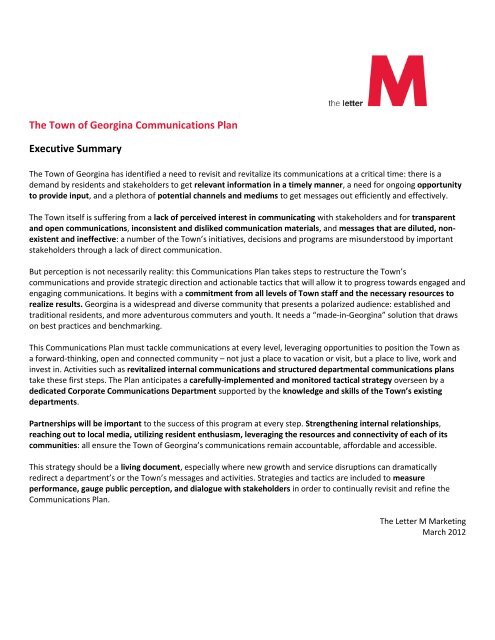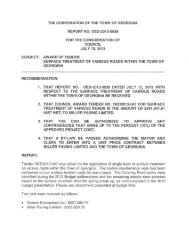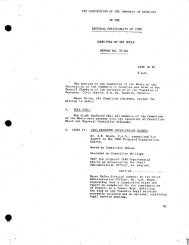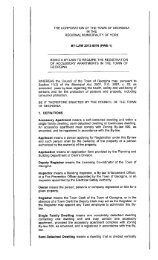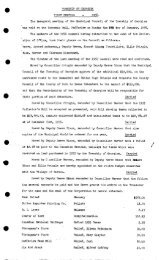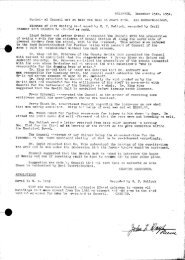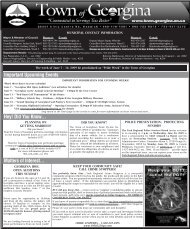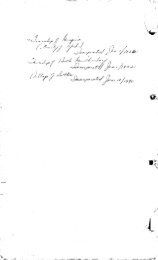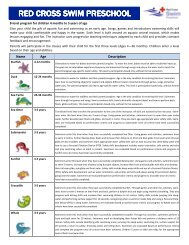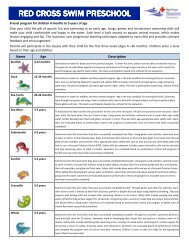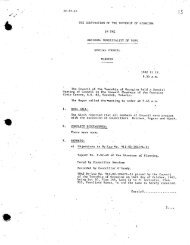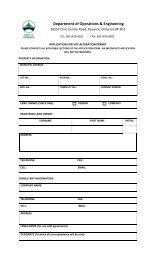The Town of Georgina Communications Plan Executive Summary
The Town of Georgina Communications Plan Executive Summary
The Town of Georgina Communications Plan Executive Summary
Create successful ePaper yourself
Turn your PDF publications into a flip-book with our unique Google optimized e-Paper software.
<strong>The</strong> <strong>Town</strong> <strong>of</strong> <strong>Georgina</strong> <strong>Communications</strong> <strong>Plan</strong>March 23, 2012Page 2 <strong>of</strong> 36A. INTRODUCTION Page1. Current <strong>Communications</strong> Overview 32. Research Activity Completed 32.1 Findings 32.2 Strategic Directions 63. Broad Objectives 93.1 Metrics 94. Audiences 104.1 Local 104.2 External 125. Key Messages 13B. COMMUNICATIONS STRATEGY6. Overarching Strategic Directions 147. Design Strategy 178. Resources 189. Issues Management 2010. Social Media Strategy 21C. COMMUNICATIONS TOOLS & TACTICS11. <strong>Communications</strong> <strong>Plan</strong> Launch 2311.1 Internal 2311.2 External 2412. <strong>Plan</strong> Rollout 2412.1 Internal <strong>Communications</strong> 2412.2 Online <strong>Communications</strong> 2512.3 Media/Public Relations 2712.4 Centralized Corporate <strong>Communications</strong> 2912.5 Facilitate Conversation 3012.6 External Markets 3313. Project Calendar and Budget 34
<strong>The</strong> <strong>Town</strong> <strong>of</strong> <strong>Georgina</strong> <strong>Communications</strong> <strong>Plan</strong>March 23, 2012Page 3 <strong>of</strong> 36A. INTRODUCTION1. Current <strong>Communications</strong> OverviewAs a growing municipality with diverse communities and committed population, <strong>The</strong> <strong>Town</strong> <strong>of</strong> <strong>Georgina</strong> has the potentialfor strong leadership in municipal branding and communications. <strong>The</strong>re is an enthusiastic internal <strong>Town</strong> audience,tourism draws, and ample opportunity for business.<strong>The</strong> <strong>Town</strong> is already making strides to educate and inform its citizens, to help attract and grow residential and visitornumbers, and entice economic investment. <strong>The</strong> current arsenal includes news pages, website, events, social mediapromotion, literature and more. Challenges include maintaining a more consistent and pr<strong>of</strong>essional visual identity,reaching and engaging more frequently with audiences, communicating effectively within the <strong>Town</strong>’s departments,creating more bold, distinctive communications, and using both conventional and less conventional methods to buildrelationships.Two key requirements to jump-start communications are a strategic and focused communications plan and committedleadership from the top levels in the <strong>Town</strong>’s municipal government right down to the front-line staff. Barriers to thesuccessful implementation <strong>of</strong> such a communications plan are real and numerous – they include human and financialresources, ingrained methods, organizational motivation/understanding, and a geographically- and demographicallyfragmentedaudience and channels.This communications plan clearly defines essential messages, tools for consistency in look and voice, robust internalcommunications, a toolkit <strong>of</strong> tactics to reach and engage all <strong>Town</strong> stakeholders as frequently as possible, and a carefullydesigneddelivery structure to ensure focus and success.2. Research Activity Completed<strong>The</strong> discovery phase <strong>of</strong> this communications project included the completion <strong>of</strong>:Materials Audit – current <strong>Town</strong> department communication materials were reviewed for content, design,positioning and efficacy.Interviews – 17 staff, council and resident telephone interviews on current <strong>Town</strong> communication methods,preferred methods, information value and two-way communications.Media Audit – review <strong>of</strong> existing press coverage related to the <strong>Town</strong> in both local and regional media, and inboth traditional print media and online coverage.Best Practices – review <strong>of</strong> comparable municipalities to determine best-practice external and internalcommunication methods and structuring.<strong>Communications</strong> Survey – 382 survey responses collected to gauge residents’ communication preferences.2.1 Findings<strong>The</strong> discovery phase revealed some specific traits about the <strong>Town</strong> <strong>of</strong> <strong>Georgina</strong> which influence communication planning:Strategica) Lack <strong>of</strong> overarching <strong>Town</strong> strategy – <strong>The</strong>re is confusion and frustration amongst stakeholders as to the <strong>Town</strong>’spriorities and overall vision. This extends to how communications fits in and how current communications are
<strong>The</strong> <strong>Town</strong> <strong>of</strong> <strong>Georgina</strong> <strong>Communications</strong> <strong>Plan</strong>March 23, 2012Page 4 <strong>of</strong> 36viewed. An overarching Strategic <strong>Plan</strong> supported by this <strong>Communications</strong> <strong>Plan</strong> will present a unified and goalorientedvision going forward.<strong>The</strong>re is also a lack <strong>of</strong> departmental awareness and consistency on key issues <strong>of</strong> communication and whatconstitutes effective communication. An overarching communications plan for each department highlighting whatshould be communicated, how it should be communicated and by whom is essential to direct successful efforts.b) Lack <strong>of</strong> structure – It does not appear as though staff is aware <strong>of</strong> the necessity <strong>of</strong> communications, or <strong>of</strong> their directresponsibilities through an established and approved process. In some cases, it was indicated that this is due to alack <strong>of</strong> structure and guidance from Council and senior management. In others it may indicate that staff may lackthe necessary skills to direct communications.c) Lack <strong>of</strong> internal communication – In many cases staff from one department operate fully independent <strong>of</strong> others interms <strong>of</strong> communications. One is not aware <strong>of</strong> what the other is doing or saying. Communication <strong>of</strong> projects, issuesand success is spotty and inconsistent. In many cases, staff hears <strong>of</strong> <strong>Town</strong> events, etc. after the fact or from externalsources.d) Little consistency – <strong>The</strong>re is a tendency amongst <strong>Town</strong> departments to “do their own thing”, which is the result <strong>of</strong> alack <strong>of</strong> an overarching strategic vision for communications. This leads to confusion and fragmentation: there is noconsistent voice or visual identity. Some departments, including the ROC and the Heritage Museum, aredemonstrating good communications practices and design, so there do exist the raw ingredients and staff whoinherently understand communications.e) Lack <strong>of</strong> impact – <strong>The</strong> majority <strong>of</strong> efforts by the <strong>Town</strong> to communicate with external audiences (based on MaterialsAudit) goes largely unnoticed and lacks impact. Other than mentioning articles in the Advocate and the <strong>Town</strong> newspages, the first response to questions on <strong>Town</strong> communication was, in many cases, “they don’t do any”. Based onthe Materials Audit however, it is obvious that a number <strong>of</strong> departments are demonstrating real success inplanning, developing and delivering communications – top among them being Fire & Emergency Services and theROC.f) Resources are limited – In many cases <strong>Town</strong> employees, in addition to their regular duties, are not able to take onadditional communication needs. <strong>The</strong>re may also not be the interest or the required skills for their involvement tobe successful. Significant up-front investment in resources (such as templates and departmental plans) will be key,as well as ongoing training to ensure staff is able to <strong>of</strong>fer the proper support to any successful communicationsplan.g) A fragmented community – <strong>The</strong>re are real and distinct divisions amongst residents and key stakeholders in the<strong>Town</strong>’s various communities: the <strong>Town</strong> is made up <strong>of</strong> many widespread communities (physical); some residents feelmore engaged and represented than others (emotional); there are more established residents who prefer the“traditional” way <strong>of</strong> doing things, and recent arrivals and commuters who look to more advanced techniques(tactical). <strong>Communications</strong> will need to address and compromise on the very different needs/wants <strong>of</strong> thesecommunities and personalities.h) Audience engagement is difficult – With such a geographically-diverse audience, and one that contains a number<strong>of</strong> commuters, successful and sustained two-way communications are difficult to implement and maintain: manydon’t have the time or desire to be engaged. In addition, a number <strong>of</strong> respondents expressed some dissatisfactionwith the commitment <strong>of</strong> Council to engage and communicate with them: finding new ways to breach this distancewill be important (i.e. see council engagement activities during the election).
<strong>The</strong> <strong>Town</strong> <strong>of</strong> <strong>Georgina</strong> <strong>Communications</strong> <strong>Plan</strong>March 23, 2012Page 5 <strong>of</strong> 36Tacticala) Limited integrated communications – Frequent and varied communications are important to continually engageindividuals and allow them to be part <strong>of</strong> the process if necessary. For example, rather than one communication onan issue or event (i.e. attend a budget meeting), several must be initiated (i.e. follow-up on meeting results, andanother on next steps) via multiple channels and mediums.b) Preferred communicationtactics exist – Respondentsthroughout all researchindicate a preference for a fewexisting communicationchannels rather thanfragmenting throughout anumber <strong>of</strong> supporting tactics(see at right). This indicatesthat stakeholders have cometo rely on these channels andimproving and repurposingthem would be morebeneficial than investing inentirely new avenues. Older ormore established residentsprefer traditional printedcommunications, whereasyouth and middle-agedresidents prefer electronicsources.In addition, residents were clear on what types <strong>of</strong> communications they prefer to receive from the <strong>Town</strong>: ratherthan high-level strategic messaging and reporting, their interest and need lies in updates on day-to-dayinformation: events, council updates, garbage pick-up information, general <strong>Town</strong> news, bylaw notices, recreationinformation, employment opportunities, library information, services (including disruptions or changes), requestsfor tender, public meetings, weather/road/public transportation updates, new developments, fees, forms andzoning. Communicating the basics <strong>of</strong> an overarching strategic vision will have to be linked to these service-focusedmessages.c) Poor media relationships and engagement – <strong>The</strong> <strong>Town</strong> is not providing necessary one-on-one engagement andoutreach to media to ensure editorial is factual and representative, or encouraging proactive or positive mediacoverage. This can be attributed to a lack <strong>of</strong> interest or comfort in communicating with media, a lack <strong>of</strong> directrelationships, and a pervasive opinion that this media relationship building is ineffective; that media has apredisposed bias against the <strong>Town</strong>. In many cases, media indicated that the absence <strong>of</strong> the <strong>Town</strong> perspective inarticles was because calls and requests for information were not returned or took too long. Effort should be madeto develop closer relationships with media and to provide good press opportunities to balance more negativecoverage.d) Communication channels are not being leveraged – <strong>The</strong> <strong>Town</strong> has a number <strong>of</strong> channels or partnerships available,such as the Chamber, community and sports groups and seniors clubs, to better and more economically
<strong>The</strong> <strong>Town</strong> <strong>of</strong> <strong>Georgina</strong> <strong>Communications</strong> <strong>Plan</strong>March 23, 2012Page 6 <strong>of</strong> 36disseminate information. It will be important to properly identify these opportunities and clearly define how eachcan be utilized.e) Overreliance on electronic communications – Given the ease and reduced expense with electroniccommunications, there can be a tendency to over-rely on them in many municipalities. Some residents in the <strong>Town</strong>do not use, or have access to, electronic media. Effort should be made to streamline and economize printedcommunications, but to nevertheless ensure a strong commitment to them in addition to electronic.f) <strong>The</strong> website is and will remain a key communication tool – In almost every case respondents were aware <strong>of</strong> andhad visited the website. An almost equal number consider it a highly useful, easy-to-navigate and successfulresource that contains relevant information, as those who consider it difficult to use, not appealing and in need <strong>of</strong> areworking.g) Social media use is limited – Although a number <strong>of</strong> <strong>Town</strong> departments are maintaining fairly successful Twitter andFacebook pages, and the majority <strong>of</strong> those interviewed were aware <strong>of</strong> them, they were generally uninterested,citing their preference for the other communication channels or a lack <strong>of</strong> desire.2.2 Strategic Directions<strong>The</strong> directions below were determined after review and analysis <strong>of</strong> the findings <strong>of</strong> our research. Equal weight was givento each research activity and these summary directions represent the majority <strong>of</strong> opinions, not the outcome <strong>of</strong> learningsfrom one stakeholder group.Strategic Leadership1. Overall vision. A <strong>Communications</strong> <strong>Plan</strong> draws on and supports a Strategic <strong>Plan</strong>. In the case <strong>of</strong> the <strong>Town</strong> <strong>of</strong> <strong>Georgina</strong>,it has been indicated that no <strong>Plan</strong> currently exists. This has led to some confusion and frustration from stakeholderswho question the <strong>Town</strong>’s direction and priorities (and therefore the communications that promote them).2. Top-down approach. Information should start with Council and Directors and be pushed out to staff before thegeneral public. As such, a renewed commitment to communications is essential at the highest levels. Mayor,Council and departmental Directors play an important role, both with the public and internally, and so this groupcan lead by example, to ensure more consistent communications efforts and results.3. <strong>Communications</strong> department. It is strongly recommended that a full-time <strong>Communications</strong> Manager beconsidered. Many <strong>of</strong> the tactics proposed in the plan require dedication and specialized skills that are not currentlyavailable within all departments. <strong>The</strong> role would include managing internal communications and Corporatecommunications (Mayor/Council), directing media inquiries, managing issues, providing support to departments asrequired (copy/graphic work), and providing strategic direction, leadership and oversight to departments throughthe creation <strong>of</strong> separate communication plans.4. Up-front investment. Current budget allocation for <strong>Town</strong> communications is too low to make a significant impact,and adding additional staffing and tactical resources will require a significant increase. This increase will be moreup-front than sustained: a higher initial investment will be required in the first year to implement the plan anddevelop tactics, with investment in subsequent years being lower. It is anticipated over time (24-36 months) thatsavings will be realized through reduced communication activities by departmental staff, and the efficiencies <strong>of</strong>pooled resources and economies <strong>of</strong> scale.
<strong>The</strong> <strong>Town</strong> <strong>of</strong> <strong>Georgina</strong> <strong>Communications</strong> <strong>Plan</strong>March 23, 2012Page 7 <strong>of</strong> 36<strong>Communications</strong> Delivery5. Centralized expertise. By hiring a <strong>Communications</strong> Manager the <strong>Town</strong> will be able to streamline communications,provide a consistent voice and visual identity, ensure more strategic and focused communications (and thussuccessful) and ensure communications support an overall strategic plan. This individual would also serve as acentral resource for departments by <strong>of</strong>fing expertise and guidance, for media by a general awareness <strong>of</strong> all <strong>Town</strong>initiatives/issues and for staff when overseeing internal communications.6. Centralize content around easy-to-recognize user themes. Focus on presenting information as one voice from the<strong>Town</strong> rather than as information from various departments. Establish communications around simple,understandable themes that are relatable to the majority: “Your Home”, “Your Property”, “Your Business”, etc.7. Recommended external communications process. Clearly define roles, responsibilities and <strong>Town</strong> spokespersons.This will ensure communications remain focused, structured, consistent and successful. Create multi-use materialsfor use by all departments to ensure visual consistency. <strong>The</strong>se materials should be developed as templates thatcarry the same core communications branding look and feel.8. Departmental communications liaison and oversight. It is recommended that one key individual from eachdepartment be selected to serve as a communications liaison. <strong>The</strong> responsibilities <strong>of</strong> this person would be to meetwith the overarching Corporate <strong>Communications</strong> Manager, collaborate on development <strong>of</strong> the department’s initialstrategic plan, ensure the plan is executed, and to serve as the department’s liaison with the Manager whenmaterials or support is necessary. Core communication skills training for these Departmental Liaisons should beconsidered.Commitment to Internal <strong>Communications</strong>9. Refine internal communications. Clear up and repurpose internal boards, locations and intranet to focusspecifically on <strong>Town</strong> communications. Clearly define the purpose/allowable uses <strong>of</strong> each resource and implementadditional tactics to address perceived gaps in internal opportunities. Examine additional opportunities to furtherengage staff through monthly or quarterly newsletters, EBlasts, internal town hall/CAO events and internaltradeshows.Proactive, <strong>Plan</strong>ned Approach10. Departmental communication plans. <strong>The</strong> <strong>Communications</strong> Manager would develop plans with each departmentthat addresses their specific communications needs, media contacts and protocol, proactive communications,messaging, etc. <strong>The</strong> plans would also indicate upcoming issues/events/programs and focused tactics tocommunication both internally and to the communities, and through partnership opportunities.11. Multi-purpose initiatives. Key to the successful implementation <strong>of</strong> the departments’ various strategiccommunications plans will be ensuring that tactics are streamlined and multi-tier. It is not enough to simplypromote the grand opening <strong>of</strong> a facility with a press release. Rather, the communication initiatives will need to beinclusive, wide-reaching and hit the intended audiences through multiple platforms in order to be effective.12. Encourage public input. Although research to-date has determined that two-way communications should not be astrong area <strong>of</strong> initial focus for the <strong>Town</strong>, input should still be solicited from audiences where appropriate, andmethods be put in place to easily capture and review it. Residents will feel more involved and positively vested in<strong>Town</strong> initiatives if there is the opportunity to influence decisions.
<strong>The</strong> <strong>Town</strong> <strong>of</strong> <strong>Georgina</strong> <strong>Communications</strong> <strong>Plan</strong>March 23, 2012Page 8 <strong>of</strong> 36Take the News to the People13. Grassroots approach. Keep communications simple, succinct, informative and focused on the day-to-day concerns<strong>of</strong> residents. If additional information is required or input requested, contact and feedback information should beclearly visible, and the contacts accessible.14. Celebrate successes. It is important to communicate why current residents and businesses chose the <strong>Town</strong> <strong>of</strong><strong>Georgina</strong> and to promote those reasons – this will require some “bragging”. Highlighting achievements such asresident or business accomplishments, <strong>Town</strong> awards, infrastructure improvements, or events are easy ways to bragwithout being too overt.15. Remote council outreach. Revisit how Mayor/Council meets and communicates with residents, and explore newand different opportunities to engage them – particularly those living or working at a distance from the civic centre.Although Councillors seemingly make themselves available via phone and email, additional tactics will help toensure all avenues <strong>of</strong> engagement are utilized.16. Direct-to-home delivery. Given the geographic fragmentation <strong>of</strong> the <strong>Town</strong> as well as the busy lives <strong>of</strong> residents andbusiness owners, ensuring that news and information gets directly to them is essential. For those unable orunwilling to pursue information, having it made directly available to them at their home/<strong>of</strong>fice is important toensure at least the most rudimentary awareness exists.Balance Modern and Traditional17. Focus on what works right now. <strong>The</strong>re needs to be success in strengthening existing communications beforeintroducing new and inherently more complex methods. Stakeholders have come to rely on certain channels andimmediate change would be difficult and unwelcome in many cases. Part <strong>of</strong> the role <strong>of</strong> the <strong>Communications</strong>Manager will be to research and evaluate new opportunities (see Micros<strong>of</strong>t’s <strong>Town</strong> Hall s<strong>of</strong>tware for moderatedonline forums). It should be noted that in the survey, <strong>of</strong> the 200 responses to the question on “usefulness, ease-<strong>of</strong>useand accessibility <strong>of</strong> communications from the <strong>Town</strong>”, 88 respondents indicated that they had no issues.18. Allow choice. <strong>Communications</strong> should not be made available in only one method or medium. It is supportedthrough research that a large majority <strong>of</strong> <strong>Town</strong> residents and stakeholders rely on a number <strong>of</strong> key resources to gettheir information. As such, when information is made available in one format, it must also be introduced in others.19. Encourage participation in low-cost e-communications. Using measurable electronic communications is key, asthese are more budget and resource-friendly. This includes website, web ads, links, mentions in related websites,EBlasts, Enewsletters and social media. A number <strong>of</strong> residents and external audiences do primary research online,so it is essential to ensure a presence there to meet information needs.20. Revisit website resources. Research has indicated a reliance on the <strong>Town</strong>’s website for information which is onlyexpected to increase. A fairly equal number found the site adequate as those who felt it needed a design, layoutand functionality reworking. It is recommended that oversight <strong>of</strong> the website and general brand or content updates(copy, graphics, etc.) be transferred to the <strong>Communications</strong> Manager. <strong>The</strong> site’s initial overhaul and anysubsequent features/functionality (i.e. rotator programming, RSS feeds, etc.) would be managed by IT as it is now.21. Rely on newspapers and direct mail. A focus on measurable electronic communications is important as citedabove, but given the geographic diversity <strong>of</strong> the community and access to electronic resources, an equalcommitment to streamlined print communications is also essential.
<strong>The</strong> <strong>Town</strong> <strong>of</strong> <strong>Georgina</strong> <strong>Communications</strong> <strong>Plan</strong>March 23, 2012Page 9 <strong>of</strong> 36Strengthen and Sustain Media Relations22. Create and promote positive news. Minimize advertising and maximize media relations – ink is still valuable. Ratherthan putting budget into advertising, put effort into positive public relations – provide media stories, columns andrelevant, timely information; host interesting events and tell those stories; seek out and enter awards or other ‘lists’that increase credibility and visibility.23. Strengthen relationships. Creating relationships with local media is critical to raising the pr<strong>of</strong>ile <strong>of</strong> the <strong>Town</strong>. Thiscan be accomplished through traditional means such as one-on-one meetings, follow-up calls and generaldiscussions on upcoming <strong>Town</strong> news to foster a closer relationship as well as a renewed commitment tocommunications through making information (and spokespeople) easily and quickly available.External Markets24. Don’t neglect this important audience. Although a key focus <strong>of</strong> the <strong>Plan</strong> will be internal and community, it isessential that provision also be made for external communications: key to the <strong>Town</strong>’s success is continued growth,tourism and economic investment. External audiences (potential residents, businesses and tourists) can be reachedthrough advertising and corporate initiatives.Monitor and Modify25. <strong>Communications</strong> will always be a work-in-progress. Accurate measurement <strong>of</strong> the communication strategy andtactics is essential to ensure resources are being used effectively and results are being realized. It is anticipated thatthis <strong>Plan</strong> will be a working document as the <strong>Town</strong> grows – continued evaluation <strong>of</strong> opportunities and tactics by the<strong>Communications</strong> Manager will be important. This can be accomplished through community surveys, requests fromCouncillors for public input, independent audits and review by internal departments.3. Broad Objectives1. Proactive and preventative. Empower <strong>Town</strong> departments to take an individual and fresh look at theircommunications with an eye to improving development, dissemination and follow-up.2. Centralized and consistent. Streamline communication through a centralized department to eliminate fragmentedand inconsistent communications.3. Strategic and focused. Ensure each communication provides clear, relevant and timely information to stakeholders.4. Open and collaborative. Provide upfront and forthcoming communications that provide opportunities to answer orsolicit stakeholder questions or comments.5. Available and accessible. Provide information via multiple communication mediums to ensure all audiences areable to access it in an easy and timely manner.3.1 MetricsBelow are recommended measurement activities to support the <strong>Plan</strong> and its ongoing evolution by gauging theeffectiveness <strong>of</strong> communications as a whole, as well as individual activities.
<strong>The</strong> <strong>Town</strong> <strong>of</strong> <strong>Georgina</strong> <strong>Communications</strong> <strong>Plan</strong>March 23, 2012Page 10 <strong>of</strong> 361. Track and measure year-over-year increase in on-message media columns and articles, front-line communicationrequests, social media mentions and related public relations ‘chatter’. Analyze which themes or approachesgenerate the greatest pick-up. Analyze any shift in objectivity, accuracy or ‘friendliness’.2. Roughly determine the advertising dollar value <strong>of</strong> favourable PR and media activity, versus the approximated cost(staff, consultants) <strong>of</strong> the effort.3. Track staff access <strong>of</strong> intranet communications portal and which posts or areas are <strong>of</strong> the greatest and least interest.4. Monitor website traffic patterns, identifying major tends - growths, dips - and understanding the most used areasto guide future development. Continue to track incoming queries via website contact form, and institute a onenumberinquiry line on the website that redirects to <strong>Town</strong> departments.5. Track e-communication subscribers, and any EBlast open and click-through rates. Evaluate which articles/featuresare most read and enhance future communication themes accordingly.6. Track overall event attendance and related leads. Follow-up all leads from shows, conferences and related events.7. Administer an annual issues, awareness and satisfaction survey with <strong>Town</strong> residents and other stakeholders.8. Evaluate year-over-year public inquiry/confusion <strong>of</strong> key issues such as budgets.4. Audiences4.1 LocalMayor, Council & Municipal Staff – Communication must be done first and foremost with Mayor, Council and internalmunicipal staff as they are the key communication ambassadors, and the front-line contact when audiences requestclarification or information. <strong>Communications</strong> with this key group must be clear, concise and frequent.ResidentsEstablished – Stalwart community fixtures and multi-generational families will respond to communications andmessages that hearken to traditional and trusted avenues. Some segments <strong>of</strong> this group will also respond tomore out-<strong>of</strong>-the-box communications.New – <strong>The</strong>re is opportunity to introduce riskier messages and progressive methodologies to new residents,youth and families who tend to more greatly appreciate new ideas and new ways <strong>of</strong> doing things.Seasonal – Although seasonal residents (approx. 1,700) may not always demonstrate the greatest interest oropportunity for sustained and engaged <strong>Town</strong> communications, they are an important audience nevertheless.Effort should be made to provide them with appropriate information as determined by the <strong>Communications</strong>Manager and the departmental communications plans – both at home in the <strong>of</strong>f-season and at the cottage inthe summer. Given that the majority may not have access to electronic communications during the summer,direct mail and traditional sources (Advocate) may be more appropriate.Family and Youth – Although this audience has been addressed above, its particular importance requiresadditional focus. Effort needs to be made to reach and engage these audiences at their point <strong>of</strong> interest – thelocations they visit as families and youth rather than through static mailed pieces. Consideration should be give
<strong>The</strong> <strong>Town</strong> <strong>of</strong> <strong>Georgina</strong> <strong>Communications</strong> <strong>Plan</strong>March 23, 2012Page 11 <strong>of</strong> 36to a stronger partnership with local schools and the ROC to reach youth with a stronger focus on social media,and to events and <strong>Town</strong> facilities (arena, pools and community centres) to reach families.Media - Local reporters still significantly influence public understanding and perception. Nurturing trusted relationshipswith local media remains a cornerstone <strong>of</strong> effective communications.Both <strong>of</strong> the local papers serve various needs and should be considered for placement <strong>of</strong> press releases and other<strong>Town</strong> news.o <strong>Georgina</strong> Advocate (weekly)o Pefferlaw Post (bi-weekly)Radio still serves as a trusted source in some <strong>of</strong> the more separated communities. So while it should not be a topconsideration for paid advertising, it should still continue to serve as a communication channel.o CKDXo <strong>Georgina</strong> IslandLocal Business – Through testimonials and their participation in communications and events, businesses candemonstrate confidence and success within the <strong>Town</strong>. As such, their awareness <strong>of</strong> the <strong>Town</strong>’s communication goals willbe important. In addition, encouraging their involvement and having them be a part <strong>of</strong> <strong>Town</strong> communications willencourage ownership and loyalty to the community.Special Interest Groups/Social Groups/Community Organizations – <strong>The</strong> <strong>Town</strong> boasts a number <strong>of</strong> local groups andorganizations that could serve as communication partners or channels. This can be accomplished either through directdissemination <strong>of</strong> information through their mediums (i.e. notice in a newsletter) or word-<strong>of</strong>-mouth through contacts atthe various groups.<strong>The</strong> list below provides a high-level overview only. <strong>The</strong> <strong>Communications</strong> Manager and Departmental <strong>Communications</strong>Liaison will need to evaluate and determine which specific or additional groups will best serve the needs <strong>of</strong> theindividual department communication plans.Advisory committeesAlliance for a Better <strong>Georgina</strong>Community business groups (BIA)<strong>Georgina</strong> Chamber <strong>of</strong> Commerce<strong>Georgina</strong> IslandLadies <strong>of</strong> the LakeLocal sports associationsmomstown <strong>Georgina</strong>Neighbourhood groups and coalitionsPefferlaw Ratepayers AssociationSutton Merchants AssociationVisitor information centreYork Region Tourism
<strong>The</strong> <strong>Town</strong> <strong>of</strong> <strong>Georgina</strong> <strong>Communications</strong> <strong>Plan</strong>March 23, 2012Page 12 <strong>of</strong> 364.2 ExternalMediaTravel and tourism magazines, blogs and online forums with a focus on editorial and traditional public relations(resulting in travel features and pr<strong>of</strong>iles) rather than standard advertising.Mainstream regional and national media in newspaper, magazine and broadcast should also be targeted.Economic Development decisions can be heavily influenced by discussion and pr<strong>of</strong>ile in business media, andmedia/blogs specifically targeting relocation influencers - site selectors, commercial real estate brokers, andprovincial representatives.Potential Residents<strong>The</strong> <strong>Town</strong> <strong>of</strong> <strong>Georgina</strong> is a perfect location for families to establish themselves and take advantage <strong>of</strong> thenumerous quality <strong>of</strong> life opportunities.Visitors<strong>The</strong> <strong>Town</strong> <strong>of</strong> <strong>Georgina</strong> remains a hot-spot for seasonal cottagers, ice fishing aficionados and general tourists. As a fairlybroad and extremely varied audience (although visitors can be constrained slightly by an ideal target range <strong>of</strong> approx 2-3hours) the majority <strong>of</strong> these individuals are hard to hit and are best reached through channel and partnercommunications:Travel/info centres - Having information at these locations is beneficial because it allows awareness to becreated and can generate a spark <strong>of</strong> interest or a want to discover more about the <strong>Town</strong>. <strong>The</strong>se centres tend toattract a wide and varied audience that traditional media may miss or may be too expensive to reach.B&Bs and hotels (regional) - Easy to reach and cheap to maintain, these channels are easy to source and providea highly-captive audience.Business (Niche & Large Industry)As with tourists, the range and type <strong>of</strong> business to attract to the <strong>Town</strong> is varied in terms <strong>of</strong> category and geography.<strong>The</strong>re is strong opportunity for smaller, niche stores as well as larger industry. <strong>The</strong>se individuals are also hard to hit andare best reached through channel and partner communications:Lead Generators – This group is the primary influencer group for companies wishing to locate or relocate inOntario. <strong>The</strong>ir job is to take the requirements <strong>of</strong> the company, research possible locations and makerecommendations on communities that would fit. <strong>The</strong> primary concerns <strong>of</strong> this group are available space, costand ease <strong>of</strong> doing business. Lead generators include site selectors, the Province <strong>of</strong> Ontario,commercial/industrial real estate agents and venture capital companiesChambers <strong>of</strong> Commerce - Potential businesses and partners reach out Chambers frequently as a channelresource to determine the feasibility <strong>of</strong> doing business in a <strong>Town</strong>.Note: External business and tourist audiences are distinctively different, with different messages and tactics necessaryto reach each group. Avoid creating dual-purpose communication vehicles which aim to attract the interest <strong>of</strong> both <strong>of</strong>these audiences.
<strong>The</strong> <strong>Town</strong> <strong>of</strong> <strong>Georgina</strong> <strong>Communications</strong> <strong>Plan</strong>March 23, 2012Page 13 <strong>of</strong> 365. Key MessagesBased on research completed to-date, these proposed key messages reflect the unique strengths that the <strong>Town</strong> <strong>of</strong><strong>Georgina</strong> has the opportunity to promote to audiences. Focusing on what makes the <strong>Town</strong> unique will bring marketingand communications activities to the forefront. <strong>The</strong>se key messages should remain strong areas <strong>of</strong> focus andimprovement to ensure that the <strong>Town</strong> can promote unique values.5.1 Quiet yet close by: an ideal place for businesses and families.a. <strong>The</strong> <strong>Town</strong> <strong>of</strong> <strong>Georgina</strong> is uniquely located to be close to Ontario’s major centres and amenities, but a comfortabledistance away from urban living to <strong>of</strong>fer an affordable, safe and healthy lifestyle.b. <strong>The</strong> <strong>Town</strong>’s commerce provides a mix <strong>of</strong> entrepreneurial business opportunities, and land for large-scale industrialand corporate business needs.c. <strong>The</strong> <strong>Town</strong> is committed to supporting local business with effective municipal government, and competitivedevelopment and corporate tax rates.5.2 Offers a breathtaking natural environment with plenty to do for everyone.a. <strong>The</strong> <strong>Town</strong> <strong>of</strong> <strong>Georgina</strong> <strong>of</strong>fers glorious views, beautiful trails and parks, and pristine water with more than 50kilometres <strong>of</strong> Lake Simcoe shoreline.b. <strong>The</strong> <strong>Town</strong> provides an everyday wonderland or an oasis away for a day, with plenty to see and do for arts andculture lovers, outdoor sports enthusiasts, discerning shoppers and diners, and more.c. <strong>Georgina</strong> is stunning in the summer and busy in the winter, long-known as North America’s ice fishing capital.d. <strong>The</strong> <strong>Town</strong> and its residents care about the local natural environment and go to great lengths to protect it.5.3 A friendly, collaborative and well-run community.a. Reliable and focused leadership from the <strong>Town</strong> <strong>of</strong> <strong>Georgina</strong>’s government provides high-quality services toresidents, businesses and visitors.b. <strong>The</strong> <strong>Town</strong> is affordable and a perfect community for families, with above-average local education, healthcare andrecreation facilities.c. <strong>The</strong> <strong>Town</strong> is committed to frequent two-way communication and civic engagement to ensure it remains a trulycollaborative community.
<strong>The</strong> <strong>Town</strong> <strong>of</strong> <strong>Georgina</strong> <strong>Communications</strong> <strong>Plan</strong>March 23, 2012Page 14 <strong>of</strong> 36B. COMMUNICATIONS STRATEGY6. Overarching Strategic Directions<strong>The</strong> vision for the <strong>Town</strong> <strong>of</strong> <strong>Georgina</strong>’s communications is <strong>of</strong> a community-based, personable, engaging butencompassing feel. <strong>The</strong> new direction <strong>of</strong> communications has moved from infrequent, limited and ineffective delivery <strong>of</strong>messages to a strategic, planned and targeted approach.6.1 Introduce increased electronic communication.Include electronic communication (website, EBlast, email, social media) while being careful to ensure an equal balancewith traditional tools such as the <strong>Town</strong>’s newspapers. Increasingly residents, potential visitors and investors completeprimary research online, so a strong, but strategic presence is essential to stand out with a well-built website.1. Create a central <strong>Town</strong> Facebook page and formalize a long-term social media communications strategy to definecontent, manage responses and determine a long-term vision and goal for its success. Consider amalgamating allthe <strong>Town</strong>’s various existing pages into <strong>of</strong>fshoots <strong>of</strong> this central page. This will ensure that those who sign up for thelibrary’s Facebook page have an opportunity to view and keep up-to-date on general <strong>Town</strong> posts as well.2. Focus on creating a revamped website that is easy to navigate, intuitive and promotional. Avoid use <strong>of</strong> PDFs toensure more effective search engine optimization and ease-<strong>of</strong>-use.3. Establish email as a first line <strong>of</strong> defense for local stakeholders and issue regular, timely EBlasts/Enewsletters.Strongly promote subscriptions to build the email database through other communication channels.4. Create a “How to get involved” information section on the website communicating how residents can providefeedback and/or participate in a number <strong>of</strong> ongoing initiatives.6.2 Minimize advertising and maximize media/public relations.Rather than put budget and energy into print advertising, redirect efforts into traditional public and media relationsactivity. <strong>The</strong> <strong>Communications</strong> Manager can establish more objectivity and overall coverage than even a robustadvertising budget can afford.1. Develop and maintain an informal one-on-one communication relationship with local media - i.e. calling to provideinformation or to follow-up on articles, etc., ensure responsive and honest communication with reporters/editorialstaff, and provide constant media stories, columns and interesting information;2. Tell your good news stories. More aggressively identify and promote community examples and stories that mayhelp to balance perceived negative coverage.3. Focus on developing and supplying fulsome media information packages, or press releases at the very least, onupcoming topics or events. Consider creating and disseminating agendas well in advance <strong>of</strong> council meetings as wellto ensure media have advance awareness and can follow-up with the benefit <strong>of</strong> initial facts/information.4. Host interesting events (charity runs or <strong>Town</strong> fundraising barbeques) and tell those stories.5. Seek out and enter awards or other ‘lists’ that increase credibility and visibility.
<strong>The</strong> <strong>Town</strong> <strong>of</strong> <strong>Georgina</strong> <strong>Communications</strong> <strong>Plan</strong>March 23, 2012Page 15 <strong>of</strong> 366.3 Establish centralized, consistent, multi-use communications.<strong>The</strong> <strong>Town</strong> is a growing and engaging investment and destination location. A larger local population means morestakeholders without the history to connect fragmented communication pieces together. As such, a memorable andpr<strong>of</strong>essional visual identity is essential to compete effectively and best present the <strong>Town</strong>’s communications.A decentralized approach to communications and its resources - both money and staffing - propagates fragmentation.<strong>The</strong>refore, all communications planning and the majority <strong>of</strong> tactical execution should be centralized under a Corporate<strong>Communications</strong> Manager, as will be detailed later in this <strong>Plan</strong>.1. Ensure one overseer (Manager) for all activity, supported by a properly qualified delivery team <strong>of</strong> internal andoutsourced resources. Website, copywriting, design, email communications, and media and public relations shouldall fall under this purview.2. Focus on presenting information as coming from one voice at the <strong>Town</strong> rather than as information from variousdepartments.3. Use the most straightforward language as possible (i.e.: rather than “waste” or “trash” simply state “garbage”.)4. Create brief, action-oriented messages for initial public communication, and <strong>of</strong>fer access to more detailedbackground and FAQ documents online or by visiting the Civic Centre.5. Communication materials should be developed to serve as multi-use pieces across various channels. Similarly, mostcommunication vehicles can effectively serve the needs <strong>of</strong> many departments rather than one. Look to combinedstrategies to make the most <strong>of</strong> all activity.6. Print materials should be produced as succinctly and as inexpensively as possible. Leverage print budgets througheconomies <strong>of</strong> scale – group as many similar projects such as postcards or flyers together as possible, forconsiderable savings in printing and potentially distribution.6.4 Facilitate engaging interaction.<strong>The</strong> <strong>Town</strong> has already begun to develop its social media presence as a tool for direct engagement. Build on this withquality face-to-face interaction with citizens to nurture more fulsome conversations. Balance use <strong>of</strong> electronic media bycreating more (and fun and different) opportunities for public participation and interaction.1. Create in-person opportunities to bring municipal staff, elected <strong>of</strong>ficials and public together for interaction. Try toinject some newness, excitement and fun with out-<strong>of</strong>-the-box ideas such as travelling council meet-and-greets andinformal Civic Centre information sessions.2. Have ongoing online surveys, or a “Question <strong>of</strong> the Week” to encourage brief input and participation in dialogue onselected issues.3. Let others communicate for you. <strong>The</strong> beauty <strong>of</strong> two-way communication and social media is that once yourmessage is caught, it’s distributed with a life <strong>of</strong> its own at generally no additional cost to you.4. Encourage community-based issues management. Create a randomly populated committee comprised <strong>of</strong> staff,citizens and politicians to forecast critical issues, anticipate public opinion and guide communication priorities.
<strong>The</strong> <strong>Town</strong> <strong>of</strong> <strong>Georgina</strong> <strong>Communications</strong> <strong>Plan</strong>March 23, 2012Page 16 <strong>of</strong> 365. Formalize an approach to communication partnerships with established local organizations (business groups,Chamber) with a concise, targeted and cost-efficient strategy.6. Reaching groups in public spaces fosters discussion. Balance use <strong>of</strong> electronic media with communications instrategic locations throughout the community. Place these in areas where the audiences are open to receiving them(i.e. events bulletins at ROC and library, etc.)6.5 Enhance internal communications.Throughout the research phase staff indicated they are <strong>of</strong>ten the last to hear important information. <strong>The</strong>se people areall potential ambassadors, and present the opportunity to have an army <strong>of</strong> communicators on the street armed withtimely – and most important, accurate – information.1. Ensure brief weekly updates between department managers and their staff on communications, issues, upcomingevents and opportunities for engagement or input.2. Create biannual functions that bring all staff together to interact with senior managers and political leaders3. Create a communications committee comprised <strong>of</strong> liaisons from all departments. <strong>The</strong>se people will act as a twowaychannel, helping to identify key issues, new opportunities and opportunities to streamline initiatives.4. Centralized, internal content management. Have one person manage the Intranet in an organized fashion, andensure that what is acceptable to be posted is clear, well-communicated and in line with the communicationsstrategy.5. Initiate spot quizzes and challenges to bring an atmosphere <strong>of</strong> “fun” to staying abreast <strong>of</strong> <strong>Town</strong> news.6.6 Don’t lose sight <strong>of</strong> the external markets.Municipalities must ensure internal stakeholders, taxpayers and constituents are a top focus for communications.However, it is essential that external audiences not be forgotten when communicating.1. For each key internal communication, apply a lens that looks at how the information can be leveraged anddistributed to external audiences to the <strong>Town</strong>’s benefit.2. Participate in important forums, publications and related opportunities that put the <strong>Town</strong> <strong>of</strong> <strong>Georgina</strong> on a largerstage.3. Apply ongoing, focused media relations on targeted external markets.4. Create website sections specifically for these audiences and tailor existing information/messages to them.
<strong>The</strong> <strong>Town</strong> <strong>of</strong> <strong>Georgina</strong> <strong>Communications</strong> <strong>Plan</strong>March 23, 2012Page 17 <strong>of</strong> 367. Design StrategyIt is recommended that the <strong>Town</strong>’s current logo continue to be retained as there is significant equity in it. Although arefreshing at some point may be advisable, it serves the <strong>Town</strong>’s current needs quite well.In order to project a consistent and more pr<strong>of</strong>essional image amongst target audiences, the <strong>Town</strong> must develop aconsistent identity for materials and develop a number <strong>of</strong> key templates to be used for communications wheneverpossible.1. <strong>The</strong> <strong>Town</strong> logo must always be used on any communications piece. It should be placed in a location <strong>of</strong> prominenceand on the front and top-left whenever possible.2. <strong>The</strong> corporate colours can look heavy when used exclusively. Consider updating the overall look through the use <strong>of</strong>a bright and bold supporting colour palette. Careful use <strong>of</strong> these colours together with images will create a balance<strong>of</strong> a corporate-looking but fresh look and feel.3. Update the <strong>Town</strong>’s Brand Guidelines and make them readily available to all staff. <strong>The</strong> Guidelines should includevisual examples <strong>of</strong> positioning, acceptable/unacceptable alterations to the logo, a supporting colour palette,corporate fonts, usage <strong>of</strong> the logo on various mediums (i.e. shirts, mugs, etc.), clear space rules, size restrictionsand co-branding principles. Create a short fact sheet that quickly outlines the general look <strong>of</strong> the brand for thevarious individuals creating materials.4. Ensure a strong commitment to white space in design. Develop a clean and minimal look to materials to ensure thefocus remains on them as tools <strong>of</strong> communication – as the logo is graphically simple and straightforward, a designwith simple lines, white space, geometric shapes (blocks or circles <strong>of</strong> colour) and sans serif fonts will be mosteffective.5. A strong effort must be made to include minimal copy – each piece should undergo scrutiny to determine what canbe trimmed or removed. <strong>The</strong> more copy and clutter, the less likely it is the message will be received.6. Create a number <strong>of</strong> key templates that follow an established brand look/feel. <strong>The</strong>se may include an ad, pressrelease, Eblast, poster, email, email signatures, memo and newsletter.7. Images should be <strong>of</strong> actual <strong>Town</strong>speople or locations whenever possible and must be <strong>of</strong> acceptable quality toreproduce effectively both in electronic and high-resolution printed materials. Consideration should be given tohiring a pr<strong>of</strong>essional photographer to create a photo library or enlisting residents via a photo contest.8. Services areas, such as finance and human resources, which represent the <strong>Town</strong> as a whole, to a primarily internalaudience (residents and employees) should also use the <strong>Town</strong> logo and visual identity. Departments such asEconomic Development & Tourism, which promote the <strong>Town</strong> as a whole, but to a distinctive audience can continueto use their own distinctive looks and logos, but must use the <strong>Town</strong>’s corporate logo in a strong supporting position.
<strong>The</strong> <strong>Town</strong> <strong>of</strong> <strong>Georgina</strong> <strong>Communications</strong> <strong>Plan</strong>March 23, 2012Page 18 <strong>of</strong> 368. ResourcesImplementation <strong>of</strong> this <strong>Plan</strong>’s recommendations requires a reasonable and sustained budget. Expenditures are typicallyhigher in the first year in order to develop and establish the various tactics and introduce the <strong>Communications</strong> team –with lesser investment in subsequent years as the plan rolls out. Estimated budgets are indicated in the Project Calendarincluded in this document, however annual detailed budgets should be developed to meet the coming year’s needs.<strong>The</strong> model recommended below puts a stronger emphasis on human resources expertise than on communicationsdisbursements such as advertising or printing. It is anticipated that reduced communications workload amongstdepartmental staff, as well as streamlined budgets for items such as advertising and printing through diversion to acentral communications team, will result in increased efficiencies, more successful communications and reducedexpenditures.Recommended staffing model:CAOCORPORATE COMMUNICATIONS MANAGER Overall strategic leadershipPROJECT COORDINATOR/DESIGNERDepartment project support, graphic designADMIN SERVICES/IT COMMUNICATIONS LIAISON Department plan implementation Website restructuring and functionalityENGINEERING/PUBLIC WORKS COMMUNICATIONS LIAISON Department plan implementation .PLANNING/BUILDING COMMUNICATIONS LIAISON Department plan implementation .REC, PARKS, CULTURE COMMUNICATIONS LIAISON Department plan implementation .LIBRARY COMMUNICATIONS LIAISON Department plan implementation .FIRE & EMERGENCY SERVICES COMMUNICATIONS LIAISON Department plan implementation<strong>Town</strong> <strong>of</strong><strong>Georgina</strong>COMMS.TEAMBimonthlyTeam MeetingsIssuesIDOngoingT&D supportECONOMIC DEVT. & TOURISM MARKETING/COMMS MGR. Marketing plan development and implementation Liaison with Corporate Comms. Manager Media relations (external)PROJECT SUPPORT for ALL PROGRAMS from EXTERNAL VENDOR POOLApproved by <strong>Communications</strong> Manager
<strong>The</strong> <strong>Town</strong> <strong>of</strong> <strong>Georgina</strong> <strong>Communications</strong> <strong>Plan</strong>March 23, 2012Page 19 <strong>of</strong> 36Corporate <strong>Communications</strong> Manager: 1.0 FTE Reports directly to CAO. Dedicated specialist with training and experience in marketing, communications and public relations. Responsible for overseeing the communication plan’s implementation and providing overall strategiccommunications leadership. Overall department planning leadership and works with all departments to develop communication plans thataddresses specific needs (i.e. tax rate planning, capital projects, significant program changes, etc.). Providesprogram oversight and integrated program delivery. Manages CAO and Council communications. Manages internal communications (i.e. postings, staff email/ENews/newsletter, and Intranet) Drives media relations strategy and acts as primary media liaison. Provides crisis communications and emergency preparedness leadership and easy-to-implement response plans. Overseer <strong>of</strong> the brand and related compliance. Manages vendor pool.Project Coordinator/Designer: 1.0 FTE Responsible for execution <strong>of</strong> corporate communication plan requirements, liaison with individual departmentson their communications plans as project manager. Provides copywriting, layout and graphic design, event coordination/support and media relations services asrequired. Oversees web content management and social media activity (including uploading posts and tweets fromDepartmental <strong>Communications</strong> Liaisons to corporate pages). This includes periodically reviewing websitecontent and liaising with departments on updates or items to remove. Review and analyze metrics on various tactics.PositionCorporate Comms. ManagerProject Coordinator/DesignerSalary$55,000 - $65,000$35,000 - $45,000Departmental <strong>Communications</strong> LiaisonsEach department should have an existing staff member with the necessary skill set assigned to act as a communicationsliaison with Corporate <strong>Communications</strong>. <strong>The</strong> role would not be a full-time requirement and should be able to beaccommodated amongst the individual’s current responsibilities.Collaborates with <strong>Communications</strong> Manager to develop departmental communications plans and is responsiblefor implementation <strong>of</strong> the plan and selected project delivery.General liaison between department and Corporate <strong>Communications</strong>.Participates in bi-monthly communications committee meetings.Responsible for social media content development when required and serves as departmental media liaison.In addition to the roles defined above, the IT Departmental <strong>Communications</strong> Liaison would also be responsible for anywebsite restructuring and implementing functionality features and additional resources (i.e. online streaming).Economic Development and Tourism Departmental Marketing & <strong>Communications</strong> ManagerGiven the substantial additional communication requirements for economic development and tourism communications(a large external market), it is recommended that this department operate with more autonomy.
<strong>The</strong> <strong>Town</strong> <strong>of</strong> <strong>Georgina</strong> <strong>Communications</strong> <strong>Plan</strong>March 23, 2012Page 20 <strong>of</strong> 36Collaborate with <strong>Communications</strong> Manager to develop departmental communications plan and is responsiblefor implementation <strong>of</strong> the plan.Liaises with <strong>Communications</strong> Manager as necessary.Review website content on a monthly basis with an eye to removing or updating content as necessary.Maintains relationships with outside vendors as needed and coordinates directly with them on projects.Serves as departmental media liaison.<strong>Communications</strong> Committee A communications committee comprised <strong>of</strong> the various Departmental <strong>Communications</strong> Liaisons should be struckto champion the corporate <strong>Communications</strong> <strong>Plan</strong>, identify issues, help support departmental communicationprojects and identify ongoing communications training and support needs. <strong>The</strong> committee should meet bimonthly,and as needed.Outsourced Vendor(s) Agency <strong>of</strong> record: <strong>The</strong> ongoing support <strong>of</strong> a full-service agency or agencies should be considered only foroverflow branding and design requirements, complex issues management and overall strategic communicationsdirection.9. Issues Management<strong>The</strong> intent <strong>of</strong> a <strong>Communications</strong> <strong>Plan</strong> is to take a timely, proactive versus reactive approach to events. Earlyidentification <strong>of</strong> potential issues is one <strong>of</strong> the most critical parts <strong>of</strong> effective communications. Proper issuesmanagement is about anticipating potential public relations challenges before they become problems, so the necessarysteps can be taken to garner support, prepare audiences, clarify questions before they arise, and ensure preparedness.Issues can take many forms, from complex situations such as a tax increase or new development policies, to simplecommunications such as library closures or revised ROC hours. In all cases, public awareness and positive opinion can benurtured with preparedness and careful planning.9.1 Forecasting Issues “Potential Issues” should be on the agenda at executive team meetings and <strong>Communications</strong> Committeemeetings, addressed and with next steps determined. From there, communications staff can work with therequired departments to develop a micro plan for action. Review Council agendas in advance <strong>of</strong> meetings to identify possible issues. Review local media, website and blogs <strong>of</strong> known <strong>Town</strong> watchdogs.9.2 Analyzing Issues Review and discuss at the department level if the issue is low risk, with the micro plan being developed in theprocess. Medium or high-risk issues must be addressed by the CAO, who will be responsible for analyzing the <strong>Town</strong>’s riskfrom a communications perspective, preparing a specific strategy and communicating with Council. Micro plans should include a history and background <strong>of</strong> the issue, a list <strong>of</strong> stakeholders, statistics and facts thatmight help clarify the issue, definition <strong>of</strong> the threats and opportunities related to the issue, as well as a forecast<strong>of</strong> potential scenarios and <strong>Town</strong> actions.9.3 Acting on Issues In most cases, unless otherwise directed by the CAO, staff should be notified (before external audiences) <strong>of</strong> theissue and appropriate messages and responses relayed.
<strong>The</strong> <strong>Town</strong> <strong>of</strong> <strong>Georgina</strong> <strong>Communications</strong> <strong>Plan</strong>March 23, 2012Page 21 <strong>of</strong> 36Public notification should take the form <strong>of</strong> targeted media such as news releases or a conference,advertising/open letters, posted flyers, content in existing vehicles such as newsletters, etc. Appropriate tacticswould be defined in the micro plan.For critical issues, a Civic Centre or open meeting should be planned and advertised.When required, media contact initiated by the <strong>Town</strong> will be based on factual information, and will highlight the<strong>Town</strong>’s key messaging.Close monitoring <strong>of</strong> the issue is required.A concluding report assessing the strengths, weaknesses and overall effectiveness <strong>of</strong> the micro plan should beprepared for future reference.10. Social Media StrategySocial media reaches approximately 50% <strong>of</strong> Canadians (86% - age 18-34, 62% - age 35-54, 43% -age +55) and more than40% <strong>of</strong> businesses use social media. Even though social media is not a key area <strong>of</strong> interest for the <strong>Town</strong>’s variousaudiences at this time, corporate Facebook and Twitter pages are recommended to communicate when information isupdated: using social media sends the message that the <strong>Town</strong> is progressive, open, eager to engage with its audiences,and accessible through a variety <strong>of</strong> channels.However, not all social media channels are business focused or appropriate for use by the <strong>Town</strong> <strong>of</strong> <strong>Georgina</strong>. <strong>The</strong>recommended social media tools that should be used are:FacebookLinkedIn (Economic Development)TwitterIt should be noted that while these are the recommended social media sites as <strong>of</strong> the date <strong>of</strong> the development <strong>of</strong> thisstrategy, social networking is a constantly moving target. Careful attention should be paid by the Corporate<strong>Communications</strong> Manager to remaining up-to-date on the trends in social media with careful consideration tointegrating into new platforms as they are developed and launched, and are appropriate for the <strong>Town</strong>.10.1 Facebook PageA strategy for an all-encompassing <strong>Town</strong> <strong>of</strong> <strong>Georgina</strong> Facebook page provides a framework for quickly and effectivelyresponding to comments by visitors to the page. Establishing protocols and points <strong>of</strong> contact will allow for a speed <strong>of</strong>response appropriate to the medium. However, there should not be an expectation <strong>of</strong> superior/faster customer serviceand response via Facebook if that level <strong>of</strong> response is not also standard through the <strong>Town</strong>’s telephone, email, store-levelor in-person service.Response Strategy1. Acknowledge the comment if a response will take some time to coordinate.2. Direct the inquiry to the appropriate <strong>Town</strong> contact and craft response.3. Provide a public response to the comment (may involve pointing the commenter to a section <strong>of</strong> the website orother resource).4. If the commenter is still unsatisfied, <strong>of</strong>fer to connect in private (either via phone or online) to help to resolve theissue.
<strong>The</strong> <strong>Town</strong> <strong>of</strong> <strong>Georgina</strong> <strong>Communications</strong> <strong>Plan</strong>March 23, 2012Page 22 <strong>of</strong> 36Content GenerationCorporate <strong>Communications</strong> will draw from Departmental Liaisons, news releases and other activities to create a corerepository for updates and detailed information on key themes. A number <strong>of</strong> departments currently manage their ownsocial media sites. Where possible these should be brought under the umbrella <strong>of</strong> the <strong>Town</strong>’s corporate pages andwhere not, overseen by Corporate <strong>Communications</strong> with content created/updated by the associated department.Additional Considerations1. Unless they contain slander or other inappropriate content (e.g., racism, homophobia), negative posts shouldnot be deleted. Social media users are skeptical <strong>of</strong> corporate sites that contain no negative reviews.2. Banning users for negative content on the page should be considered only as a last resort.3. Over the long term, users <strong>of</strong> the Facebook page may police some negative comments themselves. It is importantto encourage this ‘community spirit’, while ensuring (1) only <strong>Town</strong> personnel speak for the organization and (2)incorrect information is corrected as soon as possible.Sample inquiry direction chartComment <strong>Town</strong> Contact Corresponding Website Page/Resource1. General complaint2. Service inquiries3. Tax question/concern4. Rec Program inquiries5. Positive comments6. Legitimate complaints7. Illegitimatecomplaints/slander
<strong>The</strong> <strong>Town</strong> <strong>of</strong> <strong>Georgina</strong> <strong>Communications</strong> <strong>Plan</strong>March 23, 2012Page 23 <strong>of</strong> 36C. COMMUNICATIONS TOOLS & TACTICS<strong>The</strong> tools and tactics outlined are presented in a manner that allows the <strong>Town</strong> <strong>of</strong> <strong>Georgina</strong> to alter, customize andevolve them over the long term. This is a guideline <strong>of</strong> operation designed to provide information on ‘what to do” ratherthan “how to do it”. Execution <strong>of</strong> the recommended tactics is within the abilities <strong>of</strong> a Corporate <strong>Communications</strong> teammarketing and Departmental Liaisons.Stars noted at the end <strong>of</strong> each tactic, along with the estimated budgets required to complete the tactic, allow the <strong>Town</strong>to prioritize its communications going forward. Four stars is top priority. One star is lowest priority.11. <strong>Communications</strong> <strong>Plan</strong> LaunchIt is anticipated that the launch tactics will not be postponed until the hiring <strong>of</strong> a <strong>Communications</strong> Manager. As such,their development budgets anticipate that the <strong>Town</strong> will outsource these initial requirements. Tactics that assume <strong>Town</strong>development (i.e. departmental meetings) will not require outsourcing.11.1 InternalAnnounce finalized <strong>Communications</strong> <strong>Plan</strong> to staff first, detailing discoveries, action items and anticipated staffparticipation.11.1a) Meeting with Directors, Mayor, Council and CAO: Provide a high-level overview <strong>of</strong> the audit and plandevelopment process and identify key findings and resulting actions. Most important will be indicating the<strong>Town</strong>’s commitment to proactive, open and clear communications and all staff’s role in ensuring this.External Vendor Costs Expenses Priority$2,000 $200-$300 ****11.1b) Departmental meetings: Directors meet with departmental managers and staff to introduce the newcommunications plan and rationale, clearly detail how staff will be affected, how they can access resources andinformation, and their new role in proactive and meaningful communications.External Vendor Costs Expenses Priority$0 $100-$200 ****11.1c) Postings: Promote the <strong>Town</strong>’s new communications direction on the staff Intranet and internal bulletin boards,and reiterate where resources and additional information can be found. <strong>The</strong> tone and impact should be one <strong>of</strong>excitement, boldness and uniqueness.External Vendor Costs Expenses Priority$1,200 $50 ****11.1d) Staff newsletter: Launch a monthly ENews for staff (make available in print format for staff common areas aswell) to help ensure everyone stays up-to-date and aware <strong>of</strong> what is going on in the <strong>Town</strong> before reading aboutit in the local media. <strong>The</strong> newsletter should include a set area for each department to provide updates on 1-3key projects, issues or developments. It may include:
<strong>The</strong> <strong>Town</strong> <strong>of</strong> <strong>Georgina</strong> <strong>Communications</strong> <strong>Plan</strong>March 23, 2012Page 24 <strong>of</strong> 36Message from the CAODepartment pr<strong>of</strong>ileGreat communications examplesSignificant anniversaries and accomplishmentsFrom the field – contributions from staffEvent calendar11.2 ExternalExternal Vendor Costs Expenses Priority$2,500 for templates$200-$500***$3,200 per issue (content from client) $1,000-$2,000 ***Media Relations: Start <strong>of</strong>f on a strong foot through a release to local targets (paper, partners, Chamber, etc.) thatprovides high-level overview <strong>of</strong> audit and discoveries, and highlights direction, commitments and next steps. <strong>The</strong> <strong>Town</strong>should follow-up with media directly to <strong>of</strong>fer clarification and additional information.12. <strong>Plan</strong> RolloutExternal Vendor Costs Expenses Priority$600 $0 ****Roll out the full <strong>Communications</strong> <strong>Plan</strong> to audiences through a detailed tactical plan that support the overarchingstrategic directions. It is anticipated that these rollout tactics will be overseen by the <strong>Communications</strong> Manager. In mostcases therefore, they will require minimal-to-no outsourcing. Tactics that assume <strong>Town</strong> development (i.e. creation andmonitoring <strong>of</strong> a Facebook page) will not require outsourcing.12.1 Internal <strong>Communications</strong>12.1a) EBlast (updates, communication info, etc.): Create a clean and simple EBlast template – that can easily bepopulated and sent to <strong>Town</strong> staff in order to provide immediate and important updates.External Vendor Costs Expenses Priority$1,200 for template$200****$400 for each Blast$150***12.1b) <strong>Communications</strong> Best Practices: Craft a succinct two-page document that reiterates to all staff the 10 bestpractices for effective communication. Practices should touch on best resources for information, the proper wayto use email, how to field inquiries, etc.External Vendor Costs Expenses Priority$0 $150 **12.1c) Engagement Events: Hold bi-monthly staff events, such as luncheons or groups sessions, to solicit feedback oncommunications, identify issues and in general, keep staff aware and up-to-date on <strong>Town</strong> initiatives and plans.<strong>The</strong>se can be held once every quarter depending on resource availability. Each session should be followed up
<strong>The</strong> <strong>Town</strong> <strong>of</strong> <strong>Georgina</strong> <strong>Communications</strong> <strong>Plan</strong>March 23, 2012Page 25 <strong>of</strong> 36with a summary/action plan that keeps staff aware their insights and opinions are crucial to the continuedgrowth <strong>of</strong> <strong>Town</strong> communications and its success.External Vendor Costs Expenses Priority$2,500-$5,000 for planning and devel. TBD **12.1d) Intranet: Evaluate existing content on the Intranet with an eye to clearing out inappropriate or overly-personalpostings and information. Ensure that each department is adequately represented. This tool should focusspecifically on <strong>Town</strong> communications (departmental programs, news, events, etc.). Create and distribute clearguidelines on allowable postings and monitor the site regularly for adherence.External Vendor Costs Expenses Priority$0 $150 ****12.1e) Bulletin Boards: Evaluate existing content on internal bulletin boards as per above and create and distributeclear guidelines. Boards should also focus exclusively on <strong>Town</strong> communications because they are accessible tothe public as well. Personal messages or postings should be relegated to staff lounge areas only.External Vendor Costs Expenses Priority$0 $150 ****12.1f) Additional Resources: Consider introducing information computers/kiosks in facilities for staff that do not haveaccess to electronic communications.External Vendor Costs Expenses PriorityTBD TBD *12.2 Online <strong>Communications</strong>12.2a) ENews Template: Monthly <strong>Town</strong> updates such as events, closures and updates for deployment to residents andother key stakeholders. E-Newsletters are useful because they are easily and inexpensively sent to a number <strong>of</strong>recipients and are important to keep readers informed and feeling connected. E-Newsletters are also importantin encouraging engagement and two-way communication.As subscriptions must be done by request, ensure a fulsome advertising approach (“Sign up for our ENews!”)through a high-prominence Ad in local media, notice in <strong>Town</strong> news pages and existing departmental e-newsletters, posting on website and in <strong>Town</strong> facilities, insert in next tax bill or direct mail piece, and throughsocial media.External Vendor Costs Expenses Priority$1,600-$2,000 for promotion$1,500 for template$0 per issue (internal development)$2,000-$3,000$200$150************12.2b) Website: It is anticipated that only a “reskinning” <strong>of</strong> the current website will be in order at this point with amore fulsome reworking to follow when a <strong>Communications</strong> Manager has been procured. <strong>The</strong> reworking shouldtake into account the majority <strong>of</strong> complaints against the site centring on organization (ease <strong>of</strong> findinginformation), too many clicks/links, too many PDFs and a cluttered, busy look.
<strong>The</strong> <strong>Town</strong> <strong>of</strong> <strong>Georgina</strong> <strong>Communications</strong> <strong>Plan</strong>March 23, 2012Page 26 <strong>of</strong> 36<strong>The</strong> reskinning may include some reworking <strong>of</strong> the layout and visual look with the consideration <strong>of</strong> installing orexpanding a number <strong>of</strong> features highlighted by respondents throughout the research process:Rotator to better highlight key <strong>Town</strong> news and informationAdditional functionality and increased accessibility to online streaming <strong>of</strong> council meetings (keyconcerns being lack <strong>of</strong> on-screen updates – when council goes closed-door or meeting is late to start –and infrequent or broken access)Reworking <strong>of</strong> content to highlight top results according to Analytics: employment, search, calendar,contact, mail page, leisure (programs/pool), services, leisure (skate times)RSS feeds for event updates, notices, etc.One single interactive events calendar to which departments and the general public can postIncreased number <strong>of</strong> services online (i.e. dog license renewals)Removal <strong>of</strong> PDFs to increase SEO and ease-<strong>of</strong>-useConsider implementing read-aloud and other features to address requirements <strong>of</strong> those with specialneedsOngoing updates are critical to maintaining not only Search Engine Optimization (SEO) but mostimportantly value to the visitors. Create a regular schedule <strong>of</strong> updates (every other day isrecommended) to the website that also includes set days to review content with an eye to keeping it upto-dateand relevantConsider Micros<strong>of</strong>t’s <strong>Town</strong> Hall s<strong>of</strong>tware – it provides for moderated online forums that allowgeographically-spread communities to provide input on issues <strong>of</strong> importance at their leisure. At thispoint in time, this resource is far too advanced for audiences not familiar with it and who prefer moretraditional avenuesCreating the website to be mobile-friendly is also an important consideration. While a full mobile version wouldbe expensive and not <strong>of</strong>fer the ROI expected, it is recommended the revamped site be created with an eye tomobile accessibility. This can be accomplished easily through a number <strong>of</strong> Content Management Systems withintegrated mobile platforms.Although there is a strong reliance on electronic information resources, a large majority <strong>of</strong> the population stillrelies on printed informational pieces. As such, efforts should be made to ensure that materials and updatesmade to the website are also pushed out via newsletter, direct mail, press release, postings, etc. where possibleand appropriate.External Vendor Costs Expenses Priority$10,000-$15,000 for reskinning $500 ***12.2c) Facebook: As the most popular <strong>of</strong> the available social media sites, the <strong>Town</strong> should consider a corporateFacebook page that is strictly event-driven. This can include information and photos on events hosted orattended by <strong>Town</strong> members, lighter information on <strong>Town</strong> news and updates on fun things happening forresidents.Frequency: As events happen and photos become available, they should be shared on Facebook. Uploadingphotos, tagging those in the photos, linking staff to the event etc. are all important parts <strong>of</strong> a Facebook post.This will only be required for upcoming or recent events. This can include internal as well as public events,creating the feeling that your contacts “know” you better.
External Vendor Costs Expenses Priority$0 $0 ***<strong>The</strong> <strong>Town</strong> <strong>of</strong> <strong>Georgina</strong> <strong>Communications</strong> <strong>Plan</strong>March 23, 2012Page 27 <strong>of</strong> 3612.2d) Twitter: Brief updates, news, road closures and trends in the <strong>Town</strong> for residents and key external audiences areall appropriate tweets for a corporate Twitter page. Tweets need to be balanced between original informationand re-tweets from related sources and bloggers. Upcoming events and developments should be shared here.Frequency: Regular and frequent posts are required. Each post should only be shared once. Posts can be foundby following those <strong>of</strong> influence in the audiences you are trying to reach. <strong>The</strong> more people you follow, the easierit will be and the faster it will be successful.External Vendor Costs Expenses Priority$0 $0 **12.2e) Surveys: Yearly communication surveys, set up online through Survey Monkey with accompanying paper surveysleft at <strong>Town</strong> facilities, will help the <strong>Town</strong> to gauge the results <strong>of</strong> their efforts, identify trends and pinpoint newopportunities and benchmark changes in public opinion year-over-year. During the most recent communicationssurvey, one-third <strong>of</strong> respondents answered via paper survey, which indicates that a link to an online survey isnot be sufficient to capture the widest possible audience.Additional surveys should also be considered every few months to gauge stakeholder feedback on current issuesor planned projects. <strong>The</strong>y can be promoted via website, EBlast/email/newsletter and available at <strong>Town</strong> facilities.Although it is not anticipated that the response to all surveys will typically be high, it does provide a low-costand familiar way to allow feedback on items <strong>of</strong> note. Short one or two-question surveys can also be consideredfor the website as another method <strong>of</strong> engagement.External Vendor Costs Expenses Priority$0 per survey (internal devel.) $500 *12.3 Media/Public Relations12.3a) Media Relations: <strong>The</strong> local paper (Advocate) is the most popular source for <strong>Town</strong> news and information. Effortsshould be made to keep communications with the Advocate and the other identified media (Pefferlaw Post,SNAP!, and CKDX and <strong>Georgina</strong> Island radio stations) strong through press releases and one-on-one calls andbriefings as necessary and appropriate.Consideration should also be given to maintaining a low-level advertising program every week where a lug orbanner ad is placed to tout <strong>Town</strong> website resources and perhaps top three upcoming events or items <strong>of</strong> note.Every effort must be made to ensure that media receive clear and factual information in a timely manner, andthat the most knowledgeable, suitable and approved <strong>Town</strong> personnel/spokespeople are available for questionsand follow-up:Corporate <strong>Communications</strong> will facilitate positive, open relationships with media representatives.Corporate <strong>Communications</strong> creates and disseminate all press releases. In cases where a departmentmay draft its own release (i.e. <strong>Georgina</strong> Fire Department), Corporate would provide final approval andmanage distribution.An “all local media first policy” without preference to one media outlet is expected.
<strong>The</strong> <strong>Town</strong> <strong>of</strong> <strong>Georgina</strong> <strong>Communications</strong> <strong>Plan</strong>March 23, 2012Page 28 <strong>of</strong> 36People who work with media should know and respect media deadlines.Media responses should be only made by Corporate <strong>Communications</strong>, the CAO, Directors or approveddepartment experts, and should adhere to the <strong>Town</strong>’s existing Media Relations response policy. <strong>The</strong><strong>Town</strong> should endeavour to provide media training for these key people.Staff is not to issue corrections or contact reporters regarding misinformation without prior discussionwith Corporate <strong>Communications</strong>.12.3b) AdvertisingExternal Vendor Costs Expenses Priority$0 $500 ****<strong>Town</strong> News: It is essential that the <strong>Town</strong> maintain its weekly “News” page. This was a top information source forstakeholders, although the layout and content must be reworked: it was deemed confusing, unappealing andtoo cluttered (small copy) by the majority <strong>of</strong> respondents. It should contain informational snapshots with astrong push to the website, Facebook page and EBlast for details.A standard template should be developed with set locations for content, minimal copy size restrictionsmaintained, and extraneous copy removed so that the focus remains on its use as a tool for high-level corporatecommunications. Consider a standing banner/blow-out on the page advertising that job postings are online.Additional Paid Placements: Some advertising will be required as dictated by law (bids/tenders/public meetingnotices), fixed materials (Discover <strong>Georgina</strong> magazine) or the specific needs <strong>of</strong> a project (i.e. opening <strong>of</strong> the ROCor in tourism magazines). In general however, advertising should only be considered a support vehicle <strong>of</strong> othertactics employed in this plan and the various departmental communication plans, and not as a key means <strong>of</strong>communication. When it is pursued, it should only be placed in publications that are <strong>of</strong> a high enough quality tocomplement the <strong>Town</strong>.Each opportunity needs to be evaluated for its ROI by both Corporate <strong>Communications</strong> and the requestingdepartment. Effort should be made to garner editorial coverage on openings, events and tourism destinationsrather than paid advertising, which in general has less impact and is <strong>of</strong> questionable reliance by audiences.External Vendor Costs Expenses Priority$0 for <strong>Town</strong> News and ads$800 for <strong>Town</strong> News reworkingCurrent <strong>Town</strong> News + $39,217(20% less than 2011 placements)$200********12.3c) Positive News: Brainstorm a list <strong>of</strong> potential new stories to develop and push out to media – look at doing atleast one story/release per month. <strong>The</strong>se media stories, columns or snippets <strong>of</strong> interesting information shouldlook to highlight positive achievements and successes made by the <strong>Town</strong>, its staff or even residents. Ensure thata call for submissions is put out to staff through a general email or requests from the Departmental<strong>Communications</strong> Liaisons. Staff is frontline in many cases and connected with residents, meaning they will be anexcellent source <strong>of</strong> the good news stories that tend to fly under the radar.External Vendor Costs Expenses Priority$0 $250 ***
<strong>The</strong> <strong>Town</strong> <strong>of</strong> <strong>Georgina</strong> <strong>Communications</strong> <strong>Plan</strong>March 23, 2012Page 30 <strong>of</strong> 36MemoPosterEmail SignatureNewsletterDepartment Communication (i.e. notice to residents)EBlastFaxLetterheadSmall Brochure/FlyerIt is recognized that a number <strong>of</strong> departments have already developed an overarching “look” for materials basedon their own brands (ROC, Pioneer Village, library, etc.). In these cases the ability <strong>of</strong> the department to continueutilizing its look should be addressed in each departmental communications plan (or whether the look needs tobe amended to include the new overarching <strong>Town</strong> design strategy). Final approval over any departmental pieceshould continue to be made by Corporate <strong>Communications</strong> to maintain consistency.External Vendor Costs Expenses Priority$8,000-$10,000 for templates $500 ***12.5 Facilitate Conversation12.5a) Central Response: Many large and growing municipalities have endeavoured to create a central Service Desk todirect all inquiries with notable success. Although the <strong>Town</strong> receptionist serves respectably well in a similarcapacity at the moment, later consideration should be given to developing a customer service desk that canhandle the majority <strong>of</strong> requests, or forward or seek additional information when required. For example, if aresident calls or visits requesting a specific form, this individual would provide the direct online link or provide aprintout. Electronic tracking can also be employed: Corporate <strong>Communications</strong> can call the Service Desk at anypoint to determine the “issue <strong>of</strong> the day” or what information is generating the most concern or complaint.Follow-up communications can then be developed and distributed accordingly.Consideration should also be given to establishing a toll-free <strong>Town</strong> number for external inquires. <strong>The</strong> Chamber<strong>of</strong> Commerce, which has its own toll-free number, gets a number <strong>of</strong> calls there that should be directed to the<strong>Town</strong>.External Vendor Costs Expenses PriorityTBD TBD *12.5b) Central Signage: Standard and electronic signage (Civic Centre and the Ice Palace) are important communicationchannels for stakeholders. <strong>The</strong>se should be located in visible, high-traffic areas in <strong>Town</strong> and updated frequentlywith events and important information.Standard signage can take the form <strong>of</strong> bulletin boards in <strong>Town</strong> facilities where event posters can be placed andcomments can be dropped – over time, these locations will become known as places to access important, up-todateinformation. Providing communications at these locations also ensures the <strong>Town</strong>’s messaging is reachingaudiences where they already are rather than trusting more unreliable delivery methods.External Vendor Costs Expenses Priority$0 $5,000+ ****
<strong>The</strong> <strong>Town</strong> <strong>of</strong> <strong>Georgina</strong> <strong>Communications</strong> <strong>Plan</strong>March 23, 2012Page 31 <strong>of</strong> 3612.5c) Civic Centre Meetings: It was determined that Civic Centre meetings are not a preferred form <strong>of</strong>communications with residents, but given the need for municipal staff and council to connect with residents,these should not be eliminated entirely. Rather, careful consideration should be made to hold them forkey/pertinent events and information sessions, that they are held few and far between (two to three a year) andthat they take place in multiple locations to allow the various communities opportunity to participate without allhave to come to the Civic Centre.External Vendor Costs Expenses Priority$0 $200 per meeting **12.5d) Engagement Events: Hold bi-monthly events that are original and fun to encourage stakeholder engagement.<strong>The</strong>se may include a Mayor/Council bus that travels the <strong>Town</strong> to meet with constituents, Mayor’s awards,informal community barbeques or a <strong>Town</strong> fair.Heavier promotion <strong>of</strong> the online council meeting streaming would also allow opportunity to see if this tooladdresses the communities concerns on lack <strong>of</strong> available information while also circumventing the geographicdistance issue throughout communities.12.5e) Direct MailExternal Vendor Costs Expenses Priority$2,500-$5,000 for planning and devel. TBD **Consider Direct Mail drops via postal code rather than direct address to ensure as complete <strong>of</strong> coverage aspossible. Although a large majority <strong>of</strong> the population relies on printed informational pieces, an increasingnumber also make online resources their first stop. As such, efforts should be made to ensure materials andupdates via newsletter, direct mail, press release, postings, etc. also be pushed out via the website.Newsletter: Introduce a quarterly paper newsletter delivered to all homes (or via the Community Guide below)that updates residents on <strong>Town</strong> meetings, events, news, recognition and community changes. It should also bemade available online as well in archived format. Content can be pulled from the monthly Enewsletters.External Vendor Costs Expenses Priority$2,500 for template/look $0****$2,200 per issue$4,000 per edition****Annual Report: It is recommended that the <strong>Town</strong> develop and distribute an Annual Report to the community.<strong>The</strong> report should summarize the <strong>Town</strong>’s success in terms <strong>of</strong> the key strategic directions as well as other notablesuccesses, and highlight numerous good news stories as well as frame the year ahead.External Vendor Costs Expenses Priority$10,000-$12,000 $8,000-$10,000 ***
<strong>The</strong> <strong>Town</strong> <strong>of</strong> <strong>Georgina</strong> <strong>Communications</strong> <strong>Plan</strong>March 23, 2012Page 32 <strong>of</strong> 36Additional Materials: Additional printed pieces can be developed and mailed on an as-needed to provide detailson a major or complex issue (i.e. ROC development or opening invitation).External Vendor Costs Expenses Priority$0 $2,500-$5,000 ***12.5f) Waste and Recycling Calendar: It was indicated across the research that this tool is a much-valued piece thatshould be continued. Consideration should be given to furthering its usage as a communications tool byincluding a short update/report card on relevant departmental updates or objectives, inputting <strong>Town</strong> events <strong>of</strong>importance and listing top contacts for key queries.External Vendor Costs Expenses Priority$5,000-$10,000 for new look $8,000-$10,000 ****12.5g) Municipal/Community Guides: It is recommended the current Municipal and Community Guides be retainedand redesigned as necessary to reflect the new visual identity strategy. Prior to their next development, eachGuide should undergo an audit to determine what else can be included in each content-wise to minimize theneed for later additional mailings or updates (i.e. Community Guide should include all facility schedules ratherthan the ROC or pool schedules developed and distributed later).Distribution would remain as it currently stands, but each Guide would be accompanied by an issue <strong>of</strong> thenewsletter and made available online through a PDF.External Vendor Costs Expenses Priority$2,500-$5,000 for new look Current ****12.5h) Public Photo Contest: To support the new design strategy <strong>of</strong> high-quality and representative images, challengethe various communities to participate in a yearly photo contest (based on pre-set criteria and differentcategories) and have winning photographers receive a prize as well as prominently featuring their photos onnew <strong>Town</strong> materials. Submitted photos/illustrations can be judged by a selected group with awards/prizes beingdistributed to the winners from each category.External Vendor Costs Expenses Priority$2,500-$5,000 for planning and devel. $2,800 *12.5i)Community Ambassadors: Consider implementing a community ambassador program that enlists volunteercitizens to promote the <strong>Town</strong> at events and tradeshows, and who may also be available to greet visitors at <strong>Town</strong>facilities. Not only will these individuals be keen and enthusiastic community supporters, they will also beexcellent sources <strong>of</strong> information for residents and visitors and provide good word-<strong>of</strong>-mouth commentary.External Vendor Costs Expenses Priority$0 $2,500 *12.6 External MarketsAlthough the individual department plans, developed by the departmental liaison and Corporate <strong>Communications</strong>, willhighlight the specific tactical communication requirements for each, a number <strong>of</strong> tactics should be considered bestpractice when reaching out to external markets.
<strong>The</strong> <strong>Town</strong> <strong>of</strong> <strong>Georgina</strong> <strong>Communications</strong> <strong>Plan</strong>March 23, 2012Page 33 <strong>of</strong> 3612.6a) EBlast/ENews Template – Generic or department specific: Firm guidelines should be developed to guidecontent and overall messaging to ensure the piece serves the department most effectively.External Vendor Costs Expenses Priority$1,500-$4,200 for each template $200*$0 per issue (internal devel.)$150*12.6b) Tradeshows: <strong>The</strong>se events tend to be expensive to attend and staff, but they do <strong>of</strong>fer one-to-one interactionwhich is important in communicating. Consideration should be made for each event regarding ROI beforeattending. Develop multi-purpose roll-up banners or a low-cost table top display to promote the <strong>Town</strong> attradeshows.External Vendor Costs Expenses PriorityTBD for attendance costs TBD*$1,500-$2,000 graphic devel. $2,000*
<strong>The</strong> <strong>Town</strong> <strong>of</strong> <strong>Georgina</strong> <strong>Communications</strong> <strong>Plan</strong>March 23, 2012Page 34 <strong>of</strong> 3613. Project Calendar & Budget<strong>The</strong> following calendar, with the exception <strong>of</strong> the departmental communications plans, assumes that a Corporate <strong>Communications</strong> Manager and Project Coordinatorwill not be in place for year one. It anticipates that the <strong>Town</strong> will outsource initial communication requirements to external vendor/vendors. As such,the majority <strong>of</strong> the development costs below will be one-time only, or much less in later years when a full-time Manager and Coordinator are in place.Staffing BudgetCorporate <strong>Communications</strong> Manager $55,000 - $65,000Project Coordinator/Designer $35,000 - $45,000TOTAL $90,000 - $110,000+RecommendationExternalVendorTimelineExpenses Priority Q3 2012 Q4 2012 Q1 2013 Q2 2013 Q3 2013 Q4 2013 Q1 2014 Q2 2014+<strong>Communications</strong> <strong>Plan</strong> LaunchInternalMeeting with Dir./Mayor/Council/CAO 2,000 200-300 **** XDepartmental meetings 0 100-200 **** XPostings 1,200 50 **** XStaff newsletter (template) 2,500 200-500 *** XStaff newsletter (per issue) 3,200 1,000- *** X X X X X X X2,000TOTAL 8,900 1,550-3,050ExternalMedia relations 600 0 **** XTOTAL 600 0<strong>Plan</strong> RolloutInternal <strong>Communications</strong>EBlast (template) 1,200 200 **** XEBlast (per issue) 400 150 *** X X X X X X X<strong>Communications</strong> best practices 0 150 ** XEngagement events 2,500- TBD ** X X X5,000Intranet 0 150 **** X X X X X X X X
<strong>The</strong> <strong>Town</strong> <strong>of</strong> <strong>Georgina</strong> <strong>Communications</strong> <strong>Plan</strong>March 23, 2012Page 35 <strong>of</strong> 36Recommendation Vendor Expenses Priority Q3 2012 Q4 2012 Q1 2013 Q2 2013 Q3 2013 Q4 2013 Q1 2014 Q2 2014+Bulletin boards 0 150 **** X X X X X X X XAdditional resources TBD TBD * XTOTAL 4,100- 800+6,600Online <strong>Communications</strong>ENews (promotion) 1,600- 2,000- **** X X X X2,000 3,000ENews (template) 1,500 200 **** XENews (per issue) 0 150 **** X X X X X X XWebsite 10,000- 500 *** X15,000Facebook 0 0 *** XTwitter 0 0 ** XSurveys (per survey) 0 500 * X XTOTAL 13,100-18,5003,350-4,350Media/Public RelationsMedia relations 0 500 **** X X X X X X X XAdvertising (<strong>Town</strong> News and ads) 0 39,217+ **** X X X X X X X XAdvertising (<strong>Town</strong> News reworking) 800 200 **** XPositive news 0 250 *** X X X X X XEvents 2,500- TBD ** X X X X X X5,000TOTAL 3,300- 40,167+5,800Centralized Corporate <strong>Communications</strong>Departmental communication plans 0 TBD *** X XCommunication templates 8,000- 500 *** X10,000TOTAL 8,000- 500+10,000Facilitate ConversationCentral response TBD TBD * XCentral signage 0 5,000+ **** XCivic centre meetings (per meeting) 0 200 ** X X X XEngagement events 2,500-5,000TBD ** X X X X X X
<strong>The</strong> <strong>Town</strong> <strong>of</strong> <strong>Georgina</strong> <strong>Communications</strong> <strong>Plan</strong>March 23, 2012Page 36 <strong>of</strong> 36Recommendation Vendor Expenses Priority Q3 2012 Q4 2012 Q1 2013 Q2 2013 Q3 2013 Q4 2013 Q1 2014 Q2 2014+Newsletter (template) 2,500 0 **** XNewsletter (per issue) 2,200 4,000 **** X X X X X X XAnnual report 10,000- 8,000- *** X X12,000 10,000Additional materials 0 2,500- *** X X X X X X X5,000Waste and recycling calendar 5,000- 8,000- **** X X10,000 10,000Municipal/community guides 2,500- TBD **** X X5,000Public photo contest 2,500- 2,800 * X X5,000Community ambassadors 0 2,500 * XTOTAL 27,200-41,700+33,000-39,500+External MarketsEblast/ENews (template) 1,500- 200 * X4,200Eblast/ENews (per issue) 0 150 * X X X X XTradeshows (graphics) 1,500- 2,000 * X2,000Tradeshows (attendance) TBD TBD * X X X X X XTOTAL 3,000-6,200+2,350+GRAND TOTAL 68,200-98,300+81,717-90,717+


